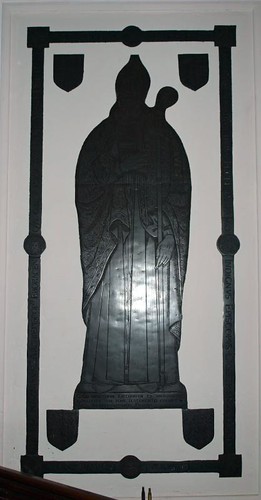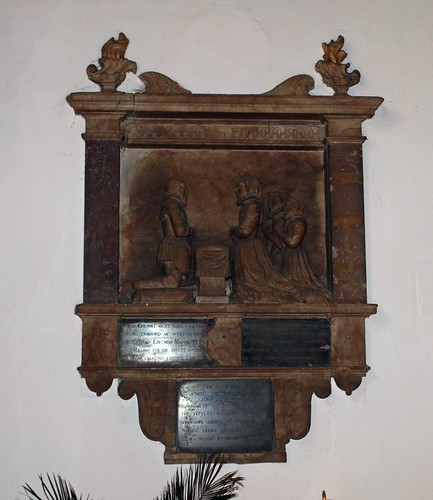St Winifred was locked with no keyholder and I can only describe it as decidedly odd.
St Mary was, coincidentally, open and compensates for a dull exterior with a great interior - nice wall monuments, some fantastic glass, a fascinating brass to Samuel Harsnett, Archbishop of York, and 17 Hatchments, the most in Essex.
ST MARY. A village church also, though enlarged in 1886 to more than twice its original size. The original church was Norman and still has its s doorway with one order of rather tall columns, one-scallop capitals, a curved lintel, an arch with zigzag decoration and a tympanum with carved diaper ornament, little squares, divided into two triangles. C15 N arcade with piers of the familiar four-shafts-four-hollows profile. C15 roof with tie-beams, king·posts and four-way struts. C15 belfry on eight posts, two against the N and two against the S wall, the remaining four forming a square in between. The usual arched braces connect the wall-posts with the square. Beams along the N and s sides of the square, and cross-strutting. Outside, the belfry is weatherboarded, painted white and has a leaded broach-spire. The C19 chancel was decorated by Bodley: stencilled walls, painted ceiling, alabaster and marble REREDOS, flanked by paintings of angels on both sides. The PULPIT also by Bodley. - STAINED GLASS. Easternmost N window by Kempe 1902.- PLATE. Paten of 1559; Secular Cup with Tudor roses and sunflowers, 1605 or 1610 ; Cup and Paten of 1633; Paten of 1633; Flagon of 1713. - MONUMENTS. Brass to Samuel Harsnett, Archbishop of York, d. 1631, bearded with cope and mitre. Frontal figure about life-size. The archbishop had been vicar of Chigwell and founded the Grammar School here. - Thomas Colshill d. 1595, and wife, small, with the usual kneeling figures facing each other.
Annoyingly I missed the Norman door in my excitement at finding St Mary open.
CHIGWELL. It is nothing like what Dickens called it, the greatest place in the world, but it has great charm in its woodland scenery, set in the valley of the River Roding between the two forests of Epping and Hainault. Chigwell has still the 17th century King’s Head Inn which Dickens brings into Barnaby Rudge as the Maypole, and its grammar school has still the original building set up by Archbishop Harsnett, who was vicar here in 1631. There is a bust of him in the hall. William Penn, the founder of Pennsylvania, was a pupil at this school. The school hall rises to the full height of the building and is a fine place. The modern chapel has windows of four scenes from the Pilgrim’s Progress, all the characters being shown as boys. Woolston Hall is a house with iron gates of the 18th century and chimneys of the 17th; Rolls is a fine house built round a 16th century block and has 17th century chimneys.
Avenues of clipped yews lead us to the old doorways of the church the Normans built; we come into it through one of their doorways, with cushion capitals on its shafts and a tympanum set in an arch of four orders. The nave and chancel are modern, but the aisle and part of its chapel were the nave and chancel of the Normans. The roof is 15th century. There are eight medieval posts in the west end of the aisle, with massive beams supporting a bell-turret above which rises a copper spire. There is a window of Ruth and Naomi, a sculpture of the Annunciation in the sanctuary, and two wall monuments of the 16th and 17th centuries, the first to Thomas Colshill, who kneels in marble with his wife and two daughters, the second a glittering tablet to George Scott, who died at Woolston Hall. Two brasses are of remarkable interest for widely varied reasons. One is a tablet erected by the busmen of London to an old friend of theirs who lived here, George Shillibeer, described on the brass as the founder of their calling - and truly so, for he ran the first buses in London and introduced the word omnibus into our language. The other brass is one of the most famous in England, the last of the five we have showing an archbishop. It is in a recess in the chancel wall, and on it is Samuel Harsnett who rose from being vicar here to be Archbishop of York, but came back to Chigwell to rest by the old church he loved. We see him on his brass, a fine bearded figure in full robes with his crozier and a book and with cherubs about him, shields-of-arms and the symbols of the Evangelists, and this unusual inscription: "Here lies Samuel Harsnett, formerly vicar of this church. First the unworthy Bishop of Chichester, then the more unworthy Bishop of Norwich, at last the very unworthy Archbishop of York." Remarkable characters were both these men.
George Shillibeer, born in London in 1797, left the Navy as a middy to learn coach-building. Setting up in business in Paris, he built two buses for a patron there, returned to London, and in 1829 placed on the streets the first omnibuses seen in England. Drawn by three horses, each carried 22 passengers, and plied between Paddington and the Bank of England at a shilling a head.
At first his only rivals were stage coaches, which covered the same journey in three hours at a cost of half-a-crown a passenger. Shillibeer furnished his vehicles with free newspapers and magazines, and dressed his conductors first in naval uniform and afterwards in velvet. In a year he had a dozen buses on the roads, and in spite of opposition from rivals, and from householders who felt that his buses vulgarised the streets, he prospered until, starting a service in opposition to the London and Greenwich Railway, he lost heavily, and several times had his property seized for licence fees.
This arrest of his industry ruined him, and the man who had transformed passenger traffic was driven off the streets. Later he invented an improved funeral hearse, which long bore his name. Beggared by his success in transporting the living, he retrieved his fortunes by carrying the dead. He died at Brighton but has lain here since 1866. All our buses sprang from his idea.
Samuel Harsnett, who has slept at Chigwell since 1631, was the son of a Colchester baker, who sent him to Pembroke College, Cambridge. His life was a succession of escapes and preferments. At the outset of his clerical career he denounced an aspect of Calvinism and was in turn denounced for Popery; made licenser of books for the Press, he narrowly averted imprisonment for passing a seditious work which he had not troubled to read. While Master of Pembroke and vice-chancellor of Cambridge University he was accused of over 50 offences, including absence from duty, slackness with accounts, and Romanising tendencies; yet, although his resignation was inevitable, he still enjoyed the favour of James the First, and proceeded from the bishopric of Chichester to that of Norwich, and from Norwich to the archbishopric of York.
A high churchman, he offended many people in many places by his arbitrary conduct, and his relentless persecution of quiet men and women who dared to worship according to their conscience. He left writings to keep his fame alive, among them a treatise exposing those who professed to cast out evil spirits, a masterly production from which Shakespeare borrowed the names of spirits mentioned by Edgar in King Lear, and from which Milton derived ideas for L’Allegro. It was to mark his thankfulness for his advance from a vicarage to an archbishopric that he built and endowed his school here and gave the church a gallery for its scholars. His library he left to his native town. Dying in Gloucestershire, he was brought here in accordance with his wish to rest at his wife’s feet.



No comments:
Post a Comment